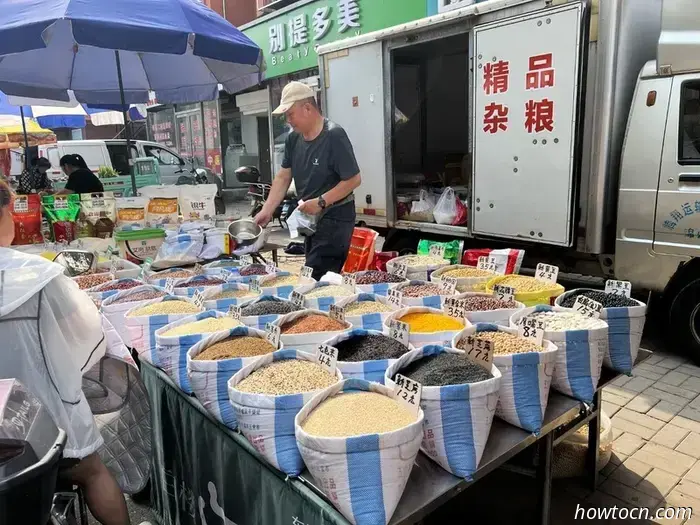
We were spending a second full day in Jinzhou more out of necessity than choice. We had one extra day before returning to Dalian and decided it would be better to remain in Jinzhou than to move to another city for just one night. I hoped we would discover interesting sights beyond the markets, as the city featured rivers with parks and attractions alongside them. We began our day at the Bailou morning market on Nanchang Road, close to the Xiaoling River in Linghe District. Although not as famous as Shiqiaozi, this market was sizable and vibrant. As always, I was struck by the vendors' creative displays that maximized visual appeal. Some tables could have been considered edible art in a food museum due to their vivid colors and shapes. I had to restrain myself from purchasing food I didn’t particularly want just because it looked so enticing.
Finding something we actually wanted to eat wasn’t a concern for long. Delicious cornbread was cooked right in front of us on large circular griddles and cut into easy-to-eat portions perfect for on-the-go consumption. Eventually, we discovered a roadside restaurant serving savory pork innard soup, adding some zest to our morning meal.
To reach the Xiaoling River, we walked through Donghu Park. There was a rundown amusement park, surprisingly featuring a few functioning rides, but even our kids weren't interested. The park itself was lush and inviting. Across a winding road was a wide promenade beside the river, where we encountered a few early morning walkers, but for the most part, we enjoyed the solitude and the shimmering reflections of residential buildings across the water.
As we made our way east along the promenade, we encountered more aspects of Jinzhou's riverside life. We passed a small concert venue and a boating club where members were paddling specially designed sprint kayaks for flatwater racing. Others were wading in the shallows and fishing from the promenade.
We noticed a promising footpath leading to a wooded area of the park. Sunlight filtered through the leaves of the white poplars surrounding the path. As we walked, we began to hear an unusual cracking sound that initially was faint but grew louder as we moved forward. The sound felt completely out of place in this serene park, and I entertained myself trying to identify its source before we reached it. I involved the kids, but none of us could figure out what was causing these sharp cracks. Eventually, we stumbled upon a large, flat area of painted concrete, and the mystery was solved. A group of mostly shirtless middle-aged men were using large metal tops and specially designed ropes with a chain in the center to produce the cracking noise. This game, known as dǎ tuóluó, has been around for centuries, but we had never encountered it in our previous ten visits to China. Mei Ling asked one of the men if she could give it a try, and soon we each took a turn. Initially, I struggled since I wasn't properly circling the whip over my head before striking the top. Once they corrected me, I finally managed to connect, though I still had a long way to go in mastering the skill.
City parks in China often serve as attractions in their own right. While parks in Western cities focus on recreation, in China they feel entirely different from the crowded, utilitarian urban environments. Ponds and lakes are prominently featured, often accompanied by walkways and bridges enhancing the connection to nature. They also act as communal spaces where young and old engage in exercise and various activities. Near the park's police station, we spotted a man playing a solo game of jiànzi, which we had seen many times before but rarely at such an expert level. He effortlessly kicked backward, elevating the shuttlecock with the soles of his feet without seeing it at the moment of impact. I couldn’t fathom the amount of practice needed to achieve such precision and timing.
While we explored Donghu Park, I was also planning our route for the afternoon. According to our online maps, we needed to cross the Xiaoling River via the Yunfei Bridge to reach Taihe District. This indicated a long walk back to the amusement park; however, we discovered a pedestrian bridge much closer that was not marked on the maps at all. Had we not spotted the bridge from the promenade, we would have missed the winding ramp that brought us up to it from the park. From there, we could see the great confluence of the Xiaoling and Nv'er rivers. Only one kayaker remained at the boat club, possibly because his friends had either paddled further down the river or decided to escape the heat. To the west, we saw the Yunfei Bridge with its impressive double white arches, which reminded me somewhat of Calatrava's Zubizuri in Bilbao, though it seemed unlikely that such a renowned architect had worked on this project. In the direction from which we had come, the dense trees

































We found ourselves spending a second complete day in Jinzhou more out of necessity than preference. With an extra day before heading back to Dalian, we determined that staying in Jinzhou would be more advantageous than moving to a new city for just one night. I was hopeful that we could discover some intriguing sights beyond the markets, as the city was interwoven with rivers that featured parks and other attractions along their banks.